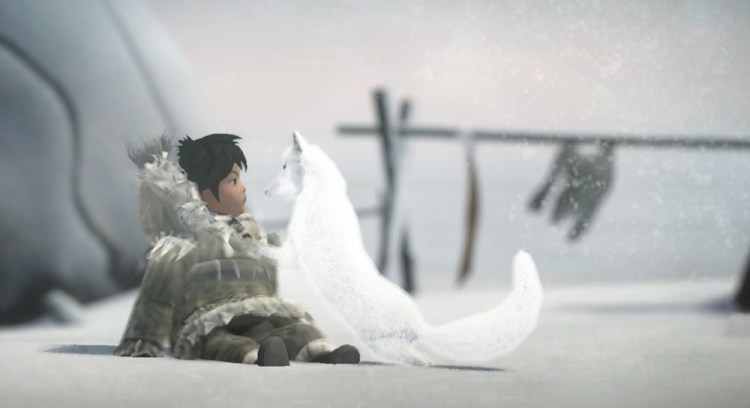GamesBeat: Are you past the point of worrying about your investment?
O’Neill: I’m past it, at least.
Pat Marrs: I don’t think any of us expected to end up starting a whole different genre. We took our stories and put them out in front of the public. It’s been amazing to see the reception. I was confident in the team all along, but—
O’Neill: Oh, we worried about it.
Marrs: Well, in the beginning it’s a risk, but we knew we could take it.
O’Neill. I know our value base has always been around partnership. We know we don’t work in isolation. It’s so important. It was really critical for us to find the right partners that align with our values. We found that. We think we got really lucky. As a result of making Never Alone together and having that inclusive development process that we established, marrying a team of game experts with Alaskan native people, we feel that we’ve done something incredible.
As a result, the board said we’re going to take our initial investment and turn that into a long-term investment. We’ve merged our assets. Now we’re one management team. We own a large share of E-Line. I’m their executive chair and our CFO is their CFO. It’s been a great process of getting to learn about the industry and then taking a major stake in the industry.
GamesBeat: I wondered what kind of success it would have, given that it was happening around the same time as we’re seeing the culture wars touch the video game industry through things like Gamergate. You tend to get the feeling that the hardest core of gamers don’t care about diversity and don’t want it anywhere near their games. That’s one message or trend that could have hurt you, but it seems as if there are other people who care more about things like this.
Angst: We were pleasantly surprised by the level of support the project received going into launch. We had very strong coverage. We had very hopeful coverage from a diverse range of game industry publications and popular media.
Like any game, we had a range of reviews. We had raves and nines and tens. We had a few rants from folks. But the rants were largely about feeling like, “I would have liked to see something more challenging from a gameplay perspective.” We felt like it was very much evaluated on its merits as a game. The special sauce that was there culturally—Obviously, for people who gave it positive reviews, that was important to them. But we were excited that we were treated with a significant critical eye in a very crowded and strong game space.
O’Neill: There’s a magic in Never Alone, a spirit in it. When people play the game, especially if they engage with two players, that’s what they come away feeling. We joke a bit saying it’s a great date-night game, because you get to overcome challenges and solve puzzles with your partner. What we’ve heard time and again is that it starts a conversation that’s meaningful and that people are able to personalize.
GamesBeat: The diversity message seems to be prevailing. We’ve seen things like Intel announcing their fund for diversity projects.
Marrs: It’s the opportunity for people to at least hear a new language spoken. It doesn’t matter where you are in the world. You have subtitles in whatever your language it is. It’s universal from that standpoint, a universal story of survival.
Angst: In time with the theme of this conference, we had surprisingly strong international coverage, especially in emerging markets. What folks found strongest about it differed substantially, if you looked at how it was covered in Russia as opposed to, say, Australia.
One thing that surprised us is that we expected people to say, “Wow, this is cool. I got to learn something about Alaskan native culture.” But much of the conversation was about their own culture and their own heritage. Something about the game got at some universal themes and caused folks to talk about how elders are important in their community, how intergenerational wisdom is passed down in their lives, or whether they had or did not have a strong heritage in their upbringing. That’s awesome, because it’s what we hoped would occur as far as it having more global appeal.
GamesBeat: What are you finding out about who’s buying the game? What’s the audience for this kind of game like?
Angst: It’s pretty diverse. There are certainly folks that like the genre. They like moody, atmospheric things in the platformer genre. Some folks really enjoy local co-op. Some other segments are people looking to play a game with their family. We often hear, “I’m a gamer and a parent. I’m always looking for things that will be engaging and challenging for my 12-year-old.” We have the family co-play happening. A surprising number of Twitch sessions, date-night Twitch sessions. That’s fun.
I’d say the largest segment is people who regard themselves as culturally creative. They want to have fun, but also want to explore something else in the world. That’s the most common theme, when you look at a Let’s Play video or something on Twitch.
O’Neill: Beyond the gamer market, what we’re being asked to participate in is conversations with the Smithsonian. They look at this as something of cultural significance. People are able to tell their stories in their own voice. People who have been underrepresented in an industry come into that industry through the investment mechanism and have a real voice. The product and the stories are genuine. The process that we use to engage in developed a product where people were heard and seen, the people of that community. I think this is the initial game that will be remembered as having some cultural significance, that will cross many boundaries and different segments of the market.



